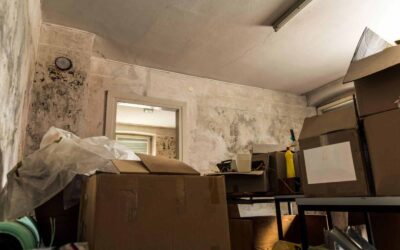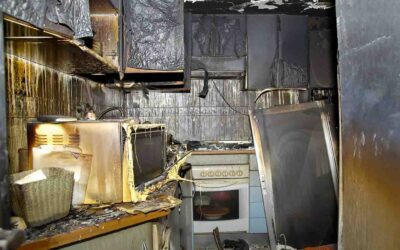Mold thrives in damp places that are neither too hot nor too cold. In the Pacific Northwest (PNW), moist, temperate conditions are the norm. So it’ll come as no surprise that mold is a common problem faced by homeowners in many areas of Oregon, Washington, and Idaho. Long rainy seasons and the mild climate make it challenging to keep infestations at bay. However, with the right strategies and a proactive approach, you can quickly learn how to prevent mold in your home, even if you live in a damp, warm environment like the Pacific Northwest.
In this blog post, we’ll cover practical methods for mold prevention specifically tailored to PNW households.
A Note About Having a “Mold-Free” Home
Keeping your home 100 percent free of mold would be ideal, but it isn’t a practical expectation. Unless every surface in your home is kept absolutely spotless at all times, it’s impossible to maintain a completely mold-free home. What you can do, however, is take steps to minimize the risk of mold growth.
Moisture from both the weather and daily indoor tasks, such as cooking or taking a shower, gets trapped inside homes, eventually seeping into walls, ceilings, floors, furniture, air ducts, and other areas. This, in turn, leads to mold growth, and with the right conditions, mold spores multiply quickly. You could have a full-blown mold infestation even before you notice you have a problem. Some household molds can damage your home and even adversely affect your health. Others aren’t as toxic but can still affect your home and its residents if left unchecked. If you discover a mold infestation, it’s always best to contact a professional.
So, how do you keep mold at bay in the PNW’s uniquely mold-friendly climate? The following tips will help you prevent mold growth in your home as much as possible.
Control Humidity Levels
You might not be able to do much about the moisture level outside your home, but you can control humidity levels inside. Mold thrives in environments with a relative humidity of over 60 percent. Keeping your home’s humidity below this threshold can significantly reduce the risk of mold growth.
One of the most common and effective ways to do this is to use a dehumidifier. Placing high-quality dehumidifiers in spaces that are prone to high humidity, such as basements, bathrooms, or kitchens, can remove excess moisture from the air, making it harder for mold to grow.
If you’re not sure which rooms need dehumidifier help most urgently, purchase a hygrometer to monitor the humidity in your home. Aim to keep humidity levels between 30 and 50 percent to create a less mold-friendly environment.
Ensure Proper Ventilation
Even with dehumidifiers, moisture is going to accumulate in your house. Steam from cooking and bathing are inevitable. Rapid changes in temperature outside can also cause condensation inside. The problem isn’t necessarily dampness in the air; rather, it’s moisture getting trapped in a room and settling onto surfaces. To prevent this, you need adequate ventilation. Properly venting a room can dramatically reduce the trapped moisture, which also reduces the chance of mold.
Make sure to use exhaust fans in high-moisture areas like bathrooms, kitchens, and laundry rooms. Always run the fan during and after activities that produce moisture, like running the washer and dryer or making dinner. Ensure that dryers and exhaust fans in your home are vented to the outside and not just into the attic. This will help remove moist air from inside your home instead of just moving it around.
On dry days, open windows to let fresh air circulate through your home. This can help reduce indoor humidity and improve air quality. Even a few minutes of ventilation each day can make a difference.
You also need to maintain your HVAC system. Regular maintenance is vital to mold prevention. Ensure that air filters are clean and regularly changed, ducts are properly cleaned and sealed, and that both your AC and furnace are functioning efficiently. A well-maintained HVAC system can go a long way to regulating indoor humidity.
Clean Regularly
Mold can start growing on surfaces within 48 hours of moisture and spore exposure, so keeping your home clean and dry is crucial. Any water spills or leaks should be cleaned up and dried ASAP. Pay special attention to problem areas like under sinks, around windows, or near plumbing fixtures.
When you make repairs or home improvements, use mold-resistant drywall, paint, sealants, and other products in areas prone to moisture. In fact, many modern building codes typically require this. This can provide an extra layer of protection against mold.
Finally, regularly inspect your home. No one is perfect, and sometimes mold might take root, but noticing it early is key to fixing it before it becomes a real problem. Look for signs of moisture or water damage, like discoloration, peeling paint, or a musty odor. Be sure to check less visible areas, like behind appliances and under carpets.
Don’t Forget Outside!
A poorly maintained home exterior can contribute to mold growth inside. Proper exterior maintenance and landscaping can keep moisture away from your home’s foundation and reduce the risk of mold.
Clogged gutters can cause water to overflow and seep into walls or your home’s foundation, leading to mold growth. Regularly cleaning your gutters can ensure that they are properly directing water away from your home.
Ground water can easily seep into your home through the foundation. To help prevent this, the ground around your home should slope away from the foundation to prevent water from pooling near the base of your home. If necessary, regrade the soil around your home to improve drainage.
If you see any cracks or gaps in the exterior of your home or foundation where water could enter, seal them as soon as possible to prevent moisture from getting inside.
What To Do If You Discover Mold
Mold prevention in the PNW requires a proactive approach due to the region’s uniquely mold-friendly climate. By controlling humidity levels and ventilation, regularly cleaning your home, and addressing common problem areas inside and outside the home, you can learn how to prevent mold and keep your home safe.
However, even if you’re meticulous, it’s possible for mold to find a hold inside your home. When this happens, contact the experts. Biodynamic is a trusted PNW-based business that has years of experience helping homeowners in the region remove mold and return their homes to a healthy state.


